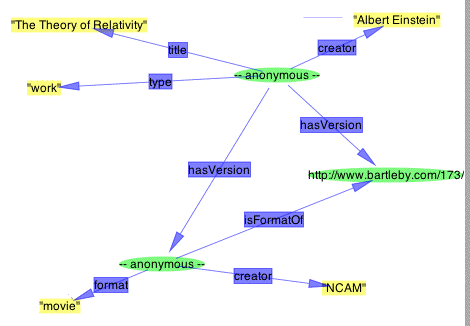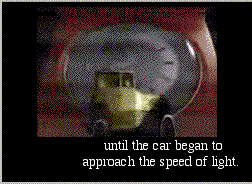Semantic Web and Accessibility
Automating the Web for everyone - Charles
McCathieNevile

This presentation was done for the Association of Internet Researchers
Conference, 18 October 2003. It was presented through a chat, so you can
read the presentation discussion as you go...
These slides are also available in a one-page
version and an SVG version. All slides were
auto-generated from the one-page version with a version of the W3C slidemaker linked to JackSVG
The one slide Semantic Web...
Something has some
relationship to something
else
- The information is on the Web
- And can be aggregated
- You can query the collection
- You can refine definitions
Wouldn't it be cool to...
- note an illustration of an idea?
- find descriptions of a painting?
- get a useful version of a document?
- find people like us?
- make this chat work better?
Let me paint you a picture...
General relativity is easy... (for physicists)
Einstein laid it all out nicely
(Oh! In German!)
and the rest of us watch the movie
- (We'll come back to the movie)
How did the Semantic Web help?
A work
Err, the picture?

Some key features
- Defined vocabularies
- (which are then mixed)
- Everything is on the Web
- Each "fact" can be anywhere
Finding a description
Easy - we just make one
Well, one each, so people can choose:
The Mona Lisa has
- A gallery catalogue entry
- A description of the paints used
- A description of the blue
- An ingredients list for the red
- "what is special" about the black
So we can
- Deal with different levels
Put together pictures without seeing them.
(A network diagram isn't a Mona Lisa)
Have our "alt text" without the drudgery...
So, a useful version of the theory
I am
- In a noisy place
- A french speaker
- Lacking concentration
I want something
- About relativity
- Appropriate for junior high
Some key standards
- ACCLip
- From the IMS global project - describing a learner's needs
- Dublin Core
- basic cataloguing from DCMI
- EARL
- Conformance to requirements, from W3C
- CC/PP
- W3C - what kind of browser features are available
- WCAG
- W3C - accessibility features like captions, ...
Leading us to...
A captioned, multilingual, described movie version by an authority...

Find people like me
An important real world case:
Maps are hard to read, but map information is ideal for the Semantic
Web
Friend of a Friend (FOAF): about
people
- Who they know
- Where they are
- What interests they have
- Photos, Documents, etc
- What language they speak
Improving realtime chat
Chatrooms can be useful multimedia collaborative tools:
chaalsNCE BLURB: Improving accessibility in real time
dc_rdfigD: Improving accessibility in real time from chaalsNCE
-->|JibberJim (SJ@dsl-217-155-143-66.zen.co.uk) has joined #rdfig
chaalsNCE D:
dc_rdfig blurb
dc_rdfig Improving accessibility in real time
chaalsNCE D: A bot could pick up a command to add a description to an
image
dc_rdfig Added comment D1.
chaalsNCE D: Or a part of an image, as in JibberJim's Shared SVG
Whiteboard
dc_rdfigAdded comment D2.
chaalsNCE D: This would allow collaborative annotation rather than
require one person do all the work
dc_rdfig Added comment D3.
chaalsNCE D2:
dc_rdfig (chaalsNCE) Or a part of an image, as in JibberJim's Shared SVG
Whiteboard
chaalsNCE D2: Or part of an image, as in [JibberJim's Shared SVG
Whiteboard| http://jibbering.com/svg/whiteboard/]
dc_rdfig Replaced comment D2.
Semantic Web programs can hang out in
chatrooms and provide interesting support...
Thank you
Questions?
- Question: please advise on visualization strategies for mapping
semantic relationships - can you provide references or web links for
research programs in this area?
- There are some important things. it turns out that people can't cope
with too many things in one diagram, so you need ways of collapsing out
the stuff that isn't immmediately relevant. So you are looking at
something like how to understand that you say zoo and I say menagerie,
and the meanings overlap. I can't provide good references for
visualisation research in this area, but most of them would be from
traditional graphic communication augmented with the ability to do
dynamic presentation. There is certainly work in this area in teh
semantic web - tools such as IsaViz with its Graphic Style Sheets, and
GraphViz which represents such information. People who studied sets,
in maths (I did it in early high school, and at a simplistic level in
lower grade school as a prelude to multiplication) will recall ways of
showing that some things are in one or other set, and some are in a
couple at a time. And that the diagram gets very complicted very
quickly. Fortunately on the Web we have dynamic formats like SVG, so
you can concentrate on the thing immediately at hand...
- Question: is PICS a good role model for metadata?
- response: A good role model... Hmmm. In the sense of being there
before it is. PICS developed into RDF - the language that W3C now uses
for the semantic Web. PICS (and in another way Dublin Core) demonstrate
the problem with "flat" models - with RDF you can build up layers of
complexity as you realise the complexity of the problems you deal with.
It is all very well to call a page of pictures and text a text
document (as Dublin Core currently does) but for accessibility that
isn't enough information. Similarly PICS is really just name-value
pairs. It is very hard to describe the relations between relationships
in PICS. But it did have the feature of demonstrating that allowing
anyone to make the statements is an important step forwards.
Bye - thanks again


